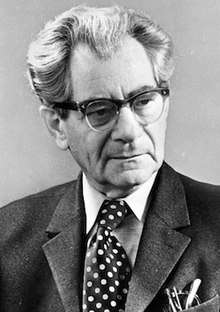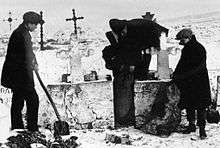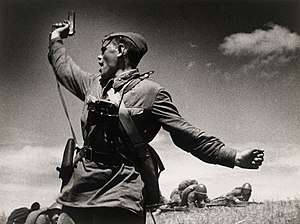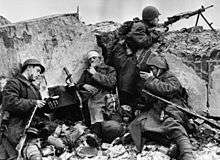Max Alpert
Max Vladimirovich Alpert (Russian: Макс Владимирович Альперт; 18 March 1899 – 30 November 1980) was a prominent Soviet photographer, who was mostly known for his frontline work during World War II.[1]
Max Alpert | |
|---|---|
 | |
| Born | 18 March 1899 Simferopol, Russian Empire |
| Died | 30 November 1980 (aged 81) Moscow, Russia |
| Occupation | Photographer |
| Known for | Kombat |
| Spouse(s) | Glafira Belits-Geiman |



Biography
Before World War I, Alpert studied in Odessa, together with his brother Mikhail Alperin, and after the war worked as a photographer for Rabochaya Gazeta (Workers Newspaper) in Moscow.[1] In the 1930s he photographed numerous construction sites of the Soviet Union. During that time Sergei Eisenstein stayed with him at the Fergana Canal and was impressed by his passion to photography.[2] In parallel, Alpert worked for Pravda, where he was known as a prolific portrait photographer. During World War II, he made a number of iconic photographs at the Soviet frontlines, and also documented military events in Prague and Berlin. For his work during the war he was awarded the Order of the Red Star (1943), Order of the Patriotic War (1945) and Order of the Red Banner of Labour. After the war, he worked at RIA Novosti, where he compiled a famous photoalbum of Nikolai Amosov. Examples of his images are held in the Sovfoto archive.
References
| Wikimedia Commons has media related to Max Alpert. |
- Константин Залесский (2015). Великая Отечественная война. Большая биографическая энциклопедия. АСТ. pp. 1929–. ISBN 978-5-457-27697-0.
- МЫ ЗДЕСЬ – Публикации. newswe.com. March 2010